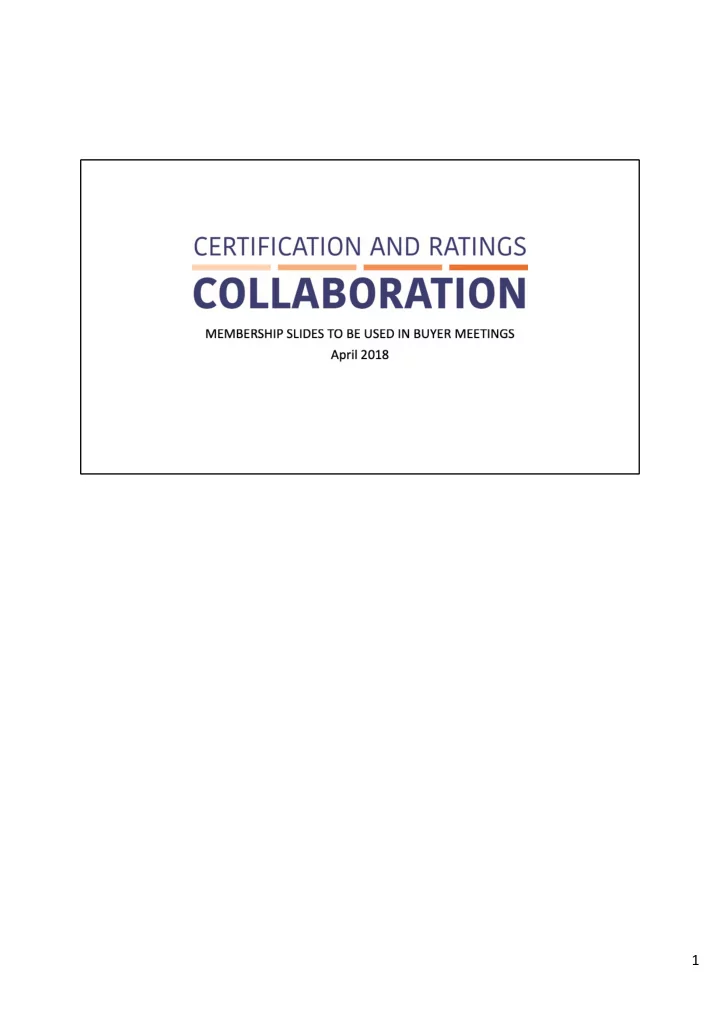

1
Collaboration overview • Established in 2015, the Certification and Ratings Collaboration is an effort among five global seafood certification and ratings programs to coordinate our tools and increase our impact so that more seafood producers move along a clear path toward environmental sustainability and social responsibility. • The participating organizations are the Aquaculture Stewardship Council, Fair Trade USA, Marine Stewardship Council, Monterey Bay Aquarium Seafood Watch, and Sustainable Fisheries Partnership. Problem – why collaborate? • The certification and ratings landscape can seem confusing and seafood businesses and governments need help understanding the value of our tools and how they complement each other. • Fisheries and aquaculture producers – particularly in the developing world – need more support to move along the path toward environmental sustainability and social responsibility. • And the sustainable seafood movement as a whole needs a shared understanding of the global seafood landscape – its status and trends, what’s working and what’s not, and where the gaps are – in order to accelerate our collective impact. 2
Collaboration Purpose: • Coordinate our complementary tools for measuring and improving fishery and aquaculture performance. We are drawing upon our existing standards to create tools to help fisheries and aquaculture define a clear path for improvement as well as working to increase the efficiency of our internal systems for data, auditing, and traceability. • Communicate clearly with seafood producers and buyers about our tools and the pathway to sustainability. This includes communicating how are programs are complementary and how we fit into sourcing policies to industry in key markets such as the United States, Spain, and Japan. • Analyze and track the global landscape of sustainable seafood. We are consolidating our programs’ data on our coverage and impact with the aim of issuing a report in 2019. • Collaborate to fill gaps and scale impact. We are exploring how we align our efforts to support farmed and wild shrimp and farmed whitefish producers to improve their performance, as well as strengthen national policies that govern fisheries and aquaculture management. 3
• Certification and ratings programs have a common goal of incentivizing fisheries and aquaculture to undertake continuous improvement toward environmental sustainability, social responsibility, and economic viability. • Certification and ratings programs play complementary roles to drive improvement and meet a range of market needs for stakeholders including producers, businesses, governments, and NGOs. • Ratings focus on assessing as many seafood sources as possible in key markets to provide information on the full spectrum of low-to-high performance for fisheries and aquaculture. This information can be used to identify opportunities for producers to pursue improvement projects and certifications, as well as help businesses evaluate sourcing options. • Certifications directly engage with fisheries or farms and require them to address social and environmental challenges to improve and meet the certification standard. Certifications also engage with the supply chain to verify the sustainability/responsibility and origin of certified products. 4
• Our certification and ratings programs offer a range of tools to assess seafood performance and support different responsible sourcing strategies. 4
Aquaculture Stewardship Council Aquaculture certification program for individual farms or groups of farms Helps farms demonstrate that they achieve and maintain a high level of environmental and social performance Fair Trade USA Wild fisheries certification program for groups of small- to medium-scale fishermen and processing facilities prior to export. Helps fisheries demonstrate that they achieve a high level of social performance and are continually improving their level of environmental performance. Fisheries receive a Fair Trade premium to support fishery and community improvements. Marine Stewardship Council Wild fisheries certification program for groups defined by the target stock(s), fishing gear(s), and vessel(s) pursuing the stock. Helps fisheries demonstrate that they achieve and maintain a high level of environmental performance and no forced/child labor. 5
Monterey Bay Aquarium Seafood Watch Ratings Rates the environmental performance of specific fisheries and aquaculture (mostly at the regional level, sometimes at the farm level) Through science-based, largely involuntary assessments, Seafood Watch ratings inform stakeholders about the full range of performance of fisheries and aquaculture from low to high. Sustainable Fisheries Partnership FishSource Rates the environmental performance of specific fisheries and aquaculture zones, and is exploring the inclusion of social and economic indicators. Informs business partners about the range of performance in their seafood sources and priorities for improvement efforts. Engages seafood suppliers in fishery and aquaculture improvement projects. 5
6
7
8
9
10
Recommend
More recommend